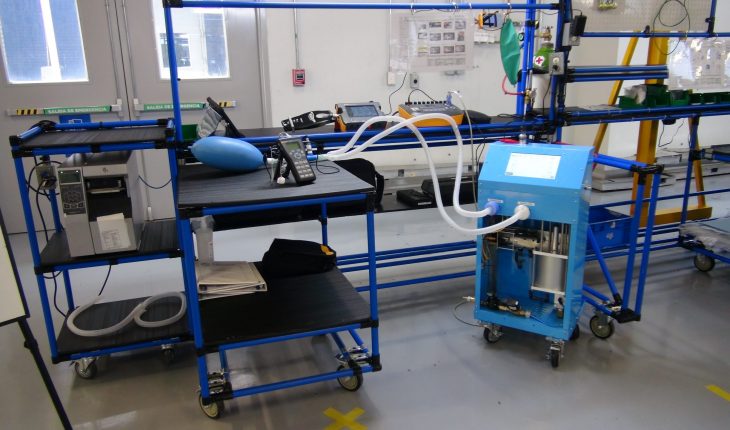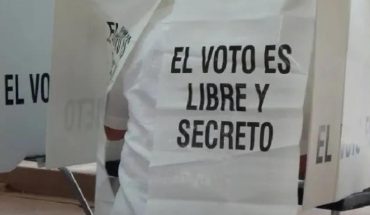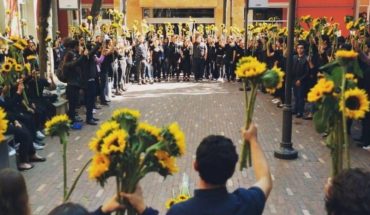March 2020. The COVID-19 pandemic is beginning to claim the first lives and confirmed cases are spreading across the country. At the end of that month, 1,215 infections and 29 deaths were reported. The so-called National Day of Sana Distancia was a week old and most Mexicans had locked themselves in their homes.
Previously, on March 24, 2020, when the closure of almost all activities in the country began, the federal government announced the infrastructure it had to deal with the health emergency: intensive care units, hospital beds, intensive care beds, emergency beds, monitors, portable X-ray equipment. , ambulances and mechanical ventilators, also known as respirators, which would be put at 100% to attend to possible infected.
That day’s report indicated that the number of ventilators available to the IMSS, the ISSSTE, and the Ministries of Health, Navy, and Defense was 5,523, a figure that from that moment on was recognized as low for the size that the epidemic was expected to take.
Ventilators are a critical tool for caring for severely ill patients infected with COVID-19 because they are ventilation machines that pump oxygen into the lungs of patients with severe breathing problems, helping them avoid what doctors call lung failure, which can lead to death.
“Respiratory fatigue is that the person, without realizing it, was breathing with greater intensity and more frequently at a higher speed, until it reaches a point that his body does not support it, and then urgently needs ventilatory support with a machine called a mechanical ventilator,” explained Hugo López-Gatell, undersecretary of Prevention and Health Promotion.
The situation was further complicated as Mexico was not the only country that needed more ventilators; the demand for these devices grew all over the world, so it was necessary to look for creative solutions to meet it because it could cost lives.
“When the pandemic hit, the need to convert certain areas into intensive care units picked up, because it was not enough for the bed, the nurse and the medicines to be there, if there was no ventilator, you couldn’t help the patient much. Now it does compromise a vital organ that if the urgency is not resolved quickly because the patient dies, “said Edith Lizeth Nicolás Martínez, an internist and intensivist doctor assigned to the intensive care area at the Salvador Zubirán National Institute of Medical Sciences and Nutrition.
* * * * *
On a Sunday in March 2020, Salvador Almaguer received a phone call. He had just about three and a half months of having left a career of more than 17 years in the automotive industry in the area of operations to change turns and now dedicate himself to the manufacture of equipment for the restaurant industry such as refrigeration devices, scales, among others.
That Sunday’s call involved him in a process that was actually a race to save lives as he was going to spend his next few weeks designing a mechanical respirator that could be used for the care of COVID patients.
“In March they talk to me on the phone and say, ‘Salvador, FEMSA executives want to help the community and they’re asking us to make ventilators.’ And I said oh, ‘how fans?’, because we were in a completely different industry. So I said well, if FEMSA managers think I can make ventilators, then we can make ventilators; then I talk to my team and tell them ‘gentlemen, they are calling us for a task that does not just involve something local, it involves a completely emergency issue because in Mexico there are no respirators,'” recalled Almaguer, Femsa’s Director of AlPunto Food Service Operations.
And from that moment began a race against time to create those devices. Studies came to know how these ventilators work, but also the human lungs.
“We started researching, we talked on the phone with doctors internationally; I personally was speaking with an eminence in the field of ventilators in Canada, we were doing a lot of research,” he added.
In early April 2020, the federal government formed a commission in which the secretariats of Health, National Defense, Navy participated, as well as the IMSS, ISSSTE and other institutions such as the National Council of Science and Technology (Conacyt), which aimed to develop a Mexican respirator.
“Then we started working with FEMSA and its subsidiaries, METALSA and some engineers from tecnológico de Monterrey”,Guillermo Domínguez Cherit, deputy director of Critical Medicine at the Salvador Zubirán National Institute of Medical Sciences and Nutrition, said.
And more and more people and institutions were joining the project: GSE Biomedical, Coppel, among others, also put expert personnel at the service of the project that ended, in record time, with the creation of the VSZ-20-2 fan, although for this several initial prototypes were made. The first of them in just three weeks added Dominguez Cherit, which had to be reinforced because it still had certain limitations.
Metalsa, a Mexican company that is dedicated to the manufacture of metal assemblies for the automotive industry was another of the companies that joined the project and contributed its expertise.
“We were very hand in hand with them, with the National Institute of Medical Sciences and Nutrition Salvador Zubirán, and Metalsa was a key part because we did all the mechanical part of the design of the ventilator, we got strong into the programming part, even the biomedical engineer of GSE we had in Monterrey ‘prototyping’ fast to be able to make the ventilator” , added Carlos Guerra, coordinator of Smart and Flexible Manufacturing in the Research and Innovation area of Metalsa.
* * * * *
Time was running out, the number of infections and deaths continues to rise while in laboratories of tec and FEMSA were working at a fast pace to have a ventilator that met the specifications of the authorities for the care of patients.
There was an additional challenge. For the design of this device it was necessary to take into account the global reality and how complicated it was at that time the import of materials, since borders and customs were closed and the components were scarce, so that only materials that were obtained in Mexico could be used.
At the beginning of 2020, most hospital ventilators used as a base what specialists know as a “ambú bag”, but after the first weeks of research, the specialists involved in this project looked for an alternative.
“When everyone was focusing on what is the ventilator ambú bag, we realized that really the need that there was in Mexico, and really the need of the COVID patient, was based on what is the mechanical respirator (…) So we started reverse engineering, we started doing the analysis of how a ventilator worked and we started designing cards that could simulate the behavior of the COVID patient, and we managed, somehow to be able to simulate the breathing that patients have during this disease and we adapted this, we did everything that is the electronic part and we started to already have what was a prototype. , Almaguer explained.
“This fan started from a fan relegated by a company called harvard apparatus. He released it 40 or 45 years ago, and it’s a principle that we use to study the physiology of the lung, the dynamic capabilities of the lung, and it’s based on a large syringe, that is, it’s a plunger that pushes the air, obviously generates a pressure and pushes the air,” Dominguez Cherit added.
Already with the basic idea of how to develop respirators for COVID patients, three main elements were established that these devices should comply with: that the supply chain for their manufacture is in Mexico, that it could be manufactured in a massive way, and that its use can be quickly learned by doctors.
“It was very tired because in those weeks we worked from sun to sun, we started at five in the morning, four in the morning, and we arrived very tired at 10 or 11 at night, but with a great satisfaction for what we achieved. Then in the evenings, around nine o’clock, we would get together with the team, ‘hey what happened, what did we do well, what did we do wrong, what can we improve?’, they were Saturdays and Sundays and it was 12 weeks super intense doing it,” Almaguer narrated.
At the same time that the approval of the respirators was sought by the health authorities of our country, the solution began to be developed so that they could be manufactured.
“The assembly line was designed and manufactured in four weeks, which for us was a record, and something we did well was what we called simultaneous engineering. While we were designing the product we have our process engineers designing the manufacturing at par to have the approval and process of the assembly line as well,” Guerra explained.
* * * * *
August 13, 2020, the first wave of COVID-19 infections and deaths was beginning to subside. On that date, 505,752 cumulative infections were reported and the number of deaths stood at 55,293. That same day, in the morning, the Secretary of Foreign Affairs, Marcelo Ebrard, leads a public event in which he recognized the “esfuunprecedented erzo between public health institutions and academics with the private sector, and the accompaniment of the Government of Mexico” for the official presentation of the invasive mechanical ventilator VSZ-20-2.
There it was reported that more than 800 Mexicans participated in that project and that by that time the figure of 3,000 ventilators had been exceeded.
For example, on June 10, there was an inventory of 8,051 ventilator beds, and on August 15 the number rose to 10,747, according to reports from the Ministry of Health.
In his presentation, it was said that the VSZ-20-2 respirator is indicated for use in patients with mild and severe acute respiratory distress syndrome (ARDS). It has a piston-based system that does not require wall air intakes for its operation; is capable of operating with pressure oxygen intake regulated at a maximum of 100psi and with minimum flow of 15 LPM, supplied with wall intake or oxygen tank; it has an uninterrupted power supply system granting an autonomy of a minimum of 30 minutes at full charge; is compatible with any standard two-way ventilation circuit; and internal sterilization of the system is not necessary.
Since it was approved by the authorities, the VSZ-20-2 began to be distributed in various entities of the country and even outside of Mexico and in this way, the medical personnel fighting the pandemic had more weapons.
“We all wanted a life-saving fan, but we also got this fan with very interesting features; for example, since it brought a battery that was put in the cart, it allowed the respirator to be relatively portable, we could push it next to the patient’s stretcher.
“The other thing that was a very pleasant surprise is that it obviously consumes less medical gases. Then it was an economical, portable and safe ventilator,” said the deputy director of Critical Medicine of the National Institute of Medical Sciences and Nutrition Salvador Zubirán.
Designing the respirators was a different challenge for many of those involved in the project than the activities they carried out on a daily basis before the pandemic.
“The automotive industry is characterized by working under pressure. What all of us on the team went through, having the goal that we can help Mexico save lives, that pressure made sense and in a way felt very different from other kinds of pressure that you can have. In fact there were several days without sleep, many weekends working, but really that motivation for the end that we were looking for really helped us to overcome that pressure,” Guerra reflected.
While it is impossible to determine how many lives have been saved since the VSZ-20-2 began to be distributed, it is clear that it was a great support for doctors who have been on the front lines of the epidemic for more than a year.
“Fortunately there was this possibility of a new respirator. What maybe we weren’t looking for was how ‘we’re going to create the best fan, let it be Touch, that it is intelligent and so on’, no, because that takes, it implies a lot of time and precisely what we did not have was that time. (…) The model did help us a lot so that, for example, for patients who at that time did not have ventilators and were on the floor or were on a waiting list to enter intensive care, it could be a bridge so that the person did not die asphyxiated, “narrated Nicolás Martínez.
* * * * *
January 2021. The second wave of COVID-19 infections and deaths is even stronger than the first. There are record numbers of infections, deaths and hospital occupancy, both of regular care beds and ventilator beds.
Although in some entities the occupancy of beds with ventilators was close to reaching 100%, on average there were more than 10,500 beds available so there was not a patient who was left without a ventilator.
“For the second upswing there were already more units, so yes he supported us a lot in that sense, I think we did not feel the shortage as at the beginning when the pandemic arrived because the ventilator of yesteryear that was analogous was taken out, and for the second upswing the truth was not felt so much that shortage, “said Nicolas Martinez.
After the second uptick, the numbers of infections, deaths and hospital occupancy have not stopped decreasing, so it will be necessary to analyze and decide what is going to be done with Mexican ventilators.
“Now we have a great opportunity, if this comes to an end soon, because maybe what I would do is we recruit all that equipment of beds, monitors, ventilators that are not going to be used and concentrate it for when a problem comes, whether it is an earthquake or a dengue crisis” , dominguez Cherit said.
Design and fabrthe VSZ-20-2 model was so successful that it was even taken to other countries where they also faced the health emergency and lacked the resources to do so.
“In total we manufacture 202 ventilators, which right now are in 45 hospitals, in 20 states here in Mexico and we export to 11 Caribbean countries. We still have few fans left to place. And because of this I think the peaks were more controlled and the demand for ventilators has already been falling,” Guerra added.
* * * * *
The little more than 14 months of the COVID-19 pandemic in Mexico have been tough. As of June 21, 2021, there are 2,478,551 confirmed cases and 231,244 deaths.
However, it is important to highlight the lessons of the health emergency. The VSZ-20-2 respirator is an example of teamwork, working under pressure and that it is possible for academia, business and government to work hand in hand.
“We had to get the best qualified labor to be able to assemble and in a way we had to weigh those people who were no longer there, whether it was the logistics, the operators, the operations people, the maintenance people even, because obviously in a certain way we had to fill those gaps that we left,” Guerra explained.
Ebrard described this work as “a national and meritorious effort because Mexico will no longer need to continue importing ventilators in the immediate future and with an effort like this, we can very quickly increase the responsiveness of our system.”
For those involved in the project, the learnings will stay there, even after the pandemic.
“This process stops teaching, first, that we can do many things when we work together, that by grouping talent there will always be a good profit, that allows us to develop something that was not imaginable or we did not have it as in the imaginary and I think it is the most fatherly teaching, “recalled Domínguez Cherit.
“I am left with that satisfaction and above all that somehow we managed to contribute something to the community, also the people, people are left with an excellent taste in their mouths, and they are satisfied that we were able to help save lives. All this made us reinvent ourselves and awaken all that part of creativity, because I believe that we Mexicans are very creative people, and the fact that we have had this opportunity to contribute something reiterates the belief that I have that in Mexico we have a lot of talent, “concluded Almaguer.




